|
SCRAMBLE DEFENSE
One of the greatest innovations of the coaching career of the legendary Dean
Smith was his famed Scramble Defense. This defense resulted from a trap
within the framework of a man-to-man defense that then turned into a trapping
defense with zone principles. Many teams have attempted to replicate what
Coach Smith pioneered at North Carolina and many have had great success with the
Scramble Defense.
The defense was a result of what Dean Smith learned from Phog Allen at Kansas
the year after Allen won his only NCAA Championship. The 1952-53 Kansas
Jayhawks were picked to finish near the bottom of the Big 7, but they made it
all the way to the national championship game for the second straight season
thanks to a defense that trapped certain ball-handlers. This
aggressiveness combined with the element of surprise gave Kansas a competitive
advantage, one that Coach Smith would take with him to the Air Force Academy as
an assistant to Bob Speer and later at North Carolina as the head coach.
Advantages of the Scramble Defense
Later in the article, I will discuss the goals of any pressure defense.
When a pressure defense like the scramble defense is implemented, the goals will
become more easily attainable. Like I said, I will save this for later.
However, there are two other big advantages that should also be taken into
consideration. The first of these is that the Scramble Defense is a great
change-up from man-to-man defense. Think of it this way: a dominant
baseball pitcher can throw a fastball in the mid- to upper-90's but still has
the devastating change-up that he throws in the low 80's that makes the hitters
swing off of their front foot. The Scramble Defense is a great change-up
to your man-to-man defense and gives the other team's offense something to think
about.
The other advantage is that the Scramble Defense is a great way to build team
chemistry. Because the defense allows any of the five players on defense
can come up with steals, this defense is a great way to get everyone to play
harder on the defensive end of the floor. When this happens, players get
excited, big plays happen, and the transition offense allows for easier scores
on the other end.
Disadvantages of the Scramble Defense
Because the Scramble Defense is a gambling-type defense, there is the
possibility of easy scores by the offense if the defense breaks down. When
this happens, the defense loses its potency and the other team's offense is able
to score. Sometimes, because of the nature of the Scramble Defense, this
can be a two-on-one situation, but rarely does this happen.
Another disadvantage of the Scramble Defense is that if all five of the players
do not play the defense the way it needs to be played, it can become disastrous.
You must have disciplined basketball players who understand their talents and
their limitations. If they do not, they can ruin the defense for everybody
else.
Goals of Any Pressure Defense
If your team runs a pressure defense, there are three
goals that should be established for any given possession. During
the course of the game, it will be to your advantage to determine the
success rate of your defense based on whether or not the defense was
successful in accomplishing these aims:
1) Steal the basketball. If you steal the
basketball you can start your transition offense and score easily.
Generate enough steals and you can win the game with your transition
offense and your pressure defense.
2) Force a deadball turnover. This is
somewhat similar to #1 in that the other team's offense turns the
basketball over thanks to the pressure. However, this goes into a
separate category considering that you cannot fast break off of a
deadball turnover. Instead, this is a time to take advantage of
the other team losing an offensive scoring opportunity and you getting
one as a result.
3) Rebound the first missed shot. Teams
that are able to get second-chance shots are more likely to win games.
If you are playing a pressure-type defense, you will be forcing
contested shots. Contested shots are more likely to be missed
which means that you will need to get the rebound. Also, if your
team allows second-chance shots, you are giving the other team more
scoring opportunities.
The bottom line is that every pressure defense should be
designed in such a way to create more scoring chances for your team and
fewer for your opponents. Keep this in mind as we go through the
intricacies of the Scramble Defense.
Types of Scramble Defense
In the Scramble Defense, there are two types of Scramble Defenses. The
first is the dribble trap and the second is the pass trap. They are
distinguished based on the action that takes place once the ball crosses a
particular pick-up point. For example, a half court dribble trap is what
takes place when the point guard dribbles the ball across the half court line as
he does in Diagram 1. When this happens, the trap is sprung with the two
nearest defenders to the trap acting as interceptors and the furthest defender
from the ball becoming the goaltender.
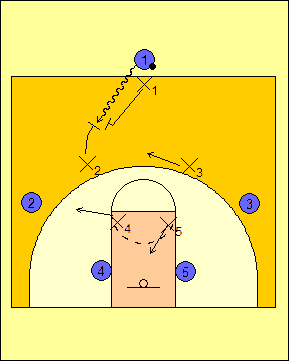
Diagram
1 |
If the point guard attempts a reverse dribble, the
Scramble Defense can still be sprung after the point guard sees the
trap coming and reverses his field. Diagram 2 shows the point
guard being turned by X1 and seeing X2 coming for the trap. X1
and X2 stay with the play and ultimately force the trap.
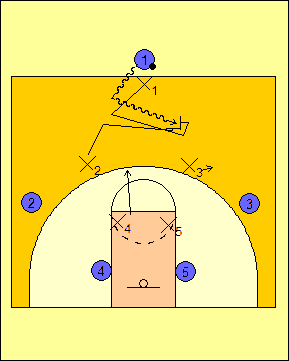
Diagram
2 |
The traps in the Scramble Defense off of the dribble can
come from either in front or from behind. Diagram 3 shows how the
defense rotates when the trap is from in front of the dribbler while
Diagram 4 shows what happens when the trap comes from behind. When
selecting a way to trap off of the dribble, it is best to pick one way
and stay with it through the season.
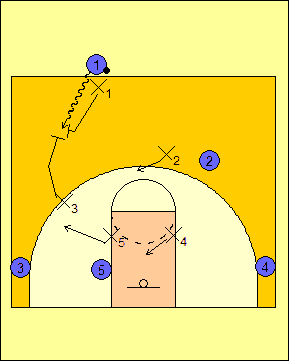
Diagram 3 |
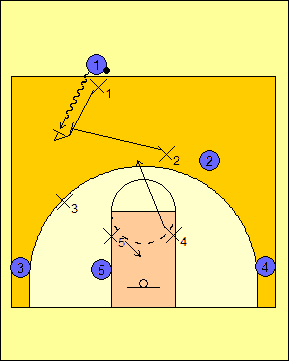
Diagram 4 |
The second type of Scramble Defense that can be run
is triggered by the first pass in the half court. These plays
are illustrated in Diagrams 5-7. The player guarding the
receiver and the passer will set the trap with the two remaining
defenders nearest the basketball playing as interceptors. The
remaining defender will be the goaltender if the ball is trapped
above the free throw line-extended but will be called the "flyer" if
the trap is set at or below the free throw line-extended.
Full Court Scramble Defense
When running the Scramble Defense, there are two
possible triggers for the trapping in the defense. The first
of these is to trap off of the inbounds pass (Diagram 8). The
ball is thrown inbounds and the man guarding the receiver and the
man guarding the inbounds passer will set the trap. Hopefully,
the ball will be inbounded into the corner which can give us the
advantage of using the baseline and the sideline as extra defenders.

Diagram
8 |
We can also run the Scramble Defense off of the
first dribble after the inbounds pass. When we set up this
defense, we want to show a full-court man-to-man press with the
inbounds passer guarded. However, once the ball is thrown
inbounds, we will not trap initially to give the offense the false
security we are in a soft man-to-man full court press (Diagram 9).
Depending on whether the dribble is up the floor (Diagram 10) or to
the middle of the floor (Diagram 11), we have to be ready to trap
when the moment comes.

Diagram
9 |

Diagram
10 |

Diagram
11 |
Scramble Rotations
When we have set the Scramble Defense, whether in
the half court or in a full-court situation, we have rules as to how
we want the defense to be set and to rotate. Diagram 12 shows
the initial set-up for a Scramble Defense trap in the full court
with two trappers (X1 and X4), two interceptors (X2 and X3), and a
goaltender (X5).
The two trappers should form a "T" with their feet
so they can prevent the step-through by the ball-handler and
minimize the possibility of a pass to split the interceptors.
The interceptors should find the three nearest receivers and split
the difference between the two nearest them. Finally, the
goaltender needs to be the deepest defender but be in a position to
rotate up to an interceptor position if necessary.

Diagram
12 |
Diagram 13 shows the rotation when the ball is
reversed from one side of the floor to the other. The trapper
in the direction of the pass and the interceptor nearest the
receiver of the pass will set the trap. The remaining trapper
and the goaltender will rotate into position to become interceptors
while the remaining interceptor will become the new goaltender.
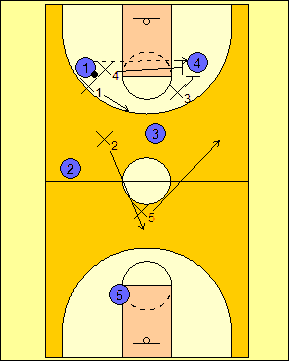
Diagram
13 |
If the ball is advanced up the floor with a pass, we
want the nearest interceptor to get between the ball-handler and the
basket (Diagram 14). If there is the possibility of setting a
trap, we will have the trapper in the direction of the pass set the
trap with the other trapper becoming an interceptor. The
goaltender becomes a ball-side interceptor while the remaining
interceptor becomes the goaltender.

Diagram
14 |
Should the offense split the trap with a pass to the
middle, we will trap with the interceptors and sprint everyone else
back in transition defense (Diagram 15). The reason we have
the interceptors become trappers is only a temporary measure to slow
down the offense. Once the slow down occurs, the
interceptors-turned-trappers will get back on defense.

Diagram
15 |
Special Scramble Situations
One of the other ways in which the Scramble Defense
can be used is on a sideline inbounds situation when we want to get
a steal. When this is what we want, we call "Either".
It's called either because we are trapping either action after the
ball is inbounded. It should be noted that the player assigned
to the inbounds passer will play in the middle of the other four
defenders in "Either".
Diagram 16 shows "Either" when the ball is inbounded
and the receiver starts dribbling. We will run the dribble
scramble immediately and get everyone in position to intercept the
basketball and to protect the basket.
Diagram 17 shows "Either" when the ball is inbounded
and the receiver passes to another offensive player immediately.
When this happens, we will go into the pass scramble and get
everyone in position to intercept the basketball and to protect the
basket.

Diagram
16 |

Diagram 17 |
Teaching the Scramble Defense
When we teach the Scramble Defense, we will
teach it using a whole-method approach only. We want to walk through the
defense so that we can work on setting the traps and rotating into the various
positions in the defense. It is imperative that this be a true team
defense because if someone does not play it as part of a unit, it will fail.
Another way that the defense can be taught and used to gain confidence is to
scrimmage a junior varsity team or some other team that has no exposure to the
Scramble Defense. When a team is unprepared for the defense, it can result
in many turnovers and lead to scores on the other end.
RETURN TO MEMBERSHIP AREA
© 2010-2017 Alan Peel Enterprises
|